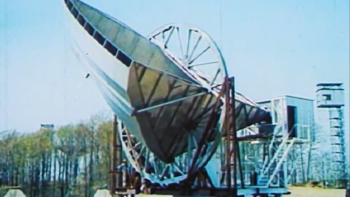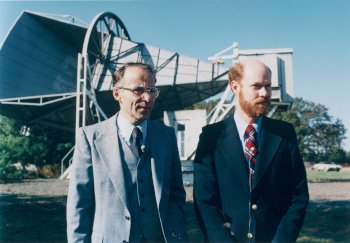Arno Penzias (1933-2024)
March 18, 2024
The
technology manager is an unique
breed of
scientist who has
knowledge not only of
science and
technology, but
business administration as well. Just as an
orchestra will quickly go off-
tempo without a
conductor, a group of
research scientists will follow their
curiosity into a scatter of directions not related to the
mission of their
corporate or
government laboratory. A technical manager is needed to ensure a reasoned
evaluation of the research done by scientists, the monitoring of scientists'
spending, and as an agent who summarizes the research of his group to a typically science-
agnostic upper management.
There are
master of science programs for technology management at many
universities. These are typically offered by their
business school; but, as a graduate of such a program told me, a scientist has no problem becoming a good technology manager, but it's likely impossible for a business administrator to become one. One scientist who made the transition to technology management was co-discoverer of the
cosmic microwave background radiation and 1978
Nobel Physics Laureate,
Arno Penzias.

Bell Labs, Murray Hill, New Jersey, in 2007, and Arno Penzias in 2007. Left image by Blaxthos, and right image by Jayan Kartik, both from Wikimedia Commons
Penzias was
director of the
AT&T Radio Physics Research Laboratory from 1976 to 1979, and had a very long tenure as
vice president of research at AT&T Bell Labs from 1981 to 1995, a period that included the
breakup of the Bell System that started the slow decline of Bell Labs as a principal research center. Arno Penzias died on January 22, 2024, at age 90.[1-4]
Penzias, whose
parents were
Polish Jews, was born in
Munich, Germany, on April 26, 1933.[1-3] In early 1939, Penzias and his four-year-old
brother, Günther,
emigrated to
England through the assistance of a
British children's rescue organization.[1] They were joined later by their parents, and the
family eventually emigrated to the
United States in late 1939.[2,4] His parents became
superintendents of an
apartment building in
New York City, which gave them an apartment free from
rent.[4] Later, his
mother worked in a
coat factory, and his
father worked as a
carpenter at the
Metropolitan Museum of Art.[4]
Penzias attended the
Brooklyn Technical High School, the
alma mater of another Nobel Laureate,
George Wald (1906-1997), who was awarded the 1967
Nobel Prize in Physiology or Medicine. In 1951, after high school, Penzias attended the
City College of New York, where he was initially enrolled in
chemical engineering.[1-2,4] At the encouragement of one of his
professors, Penzias switched his major to
physics during his
freshman year.[1-2,4] After
graduation from the City College of New York in 1954, he served two years as an
officer in the
US Army Signal Corps working on
radar.[1,3]
After two years in the Signal Corps, Penzias started
graduate school at
Columbia University (New York, NY) in the Fall of 1956.[4] His radar experience got him a
research assistantship to work on
microwave physics in the Columbia Radiation Laboratory with
I.I. Rabi (1898-1988),
Polykarp Kusch (1911-1993) and
Charles H. Townes (1915-2015).[4] Penzias did his
thesis work under Townes to build a
maser amplifier and do
radio astronomy observations.[4] He received his
Ph.D. in 1962.[3]
Penzias joined the Bell Labs Radio Physics Research Department at
Crawford Hill, Holmdel, New Jersey, in 1961 to develop microwave
receivers for radio astronomy.[1,3] Penzias originally intended to remain at Holmdel for just a short time, but he was advised by the director of the Radio Research Laboratory to accept a permanent position.[3] He was allowed to use a large
aperture (six
meter)
horn antenna at Crawford Hill for his radio astronomy observations.[1] This antenna was previously used for
radio communications in the
ECHO Satellite Program.[1] Penzias was joined in 1963 by
Robert Wilson (b. 1936) in observations of
radio emissions from the
Milky Way.[4]

The Crawford Hill horn antenna used by Arno Penzias and Robert Wilson in their radio astronomy research.
(Screenshot from a YouTube video by Nokia Bell Labs.[5] Click for larger image.)
During their observations, Penzias and Wilson observed an unexplained
baseline noise in their receiver at a
wavelength of 7.35 cm.[3] They replaced a possibly
suspect portion of the antenna and
conjectured about the source of this radio noise, thinking that it might emanate from nearby New York City, or from
pigeon excrement inside the antenna.[2,5] They saw that this baseline noise came from all regions of the sky, and it was not associated with the Milky Way.[1] They had discovered the
cosmic microwave background radiation, the afterglow of the
Big Bang.
This
radiation is the remnant of a
very early stage of the universe that occurred about 0.4 million years after the Big Bang; that is, 0.03% into the present
age of the universe, and it corresponds to a
thermal black body spectrum at a
temperature of about 2.725 K. Penzias and Wilson shared half of the 1978
Nobel Prize for Physics for their "...
fortuitous discovery of a form of radio noise that bathes the
cosmos... a crucial piece of evidence for how the
universe was created."[2] In a strange pairing of things involving low temperature, half of that year's physics prize was awarded to
Pyotr Kapitsa (1894-1984) for his work in
low temperature physics.[3]

Arno Penzias (1933-2024) (left) and Robert Wilson (b. 1936) (right), standing at the horn antenna with which they discovered the cosmic microwave background radiation.
This image was taken in 1978 at the time of their award of the Nobel Prize in Physics.
(Image compliments of the Bell Labs archives. Click for larger image.)
Subsequent to their discovery of the cosmic microwave background radiation, Penzias and Wilson searched for
interstellar molecules using the larger, 11-meter antenna at
Kitt Peak National Observatory in
Arizona, where they found the 2.6
millimeter emission line of
carbon monoxide in the
Orion Nebula.[1] At that time, Penzias became a
visiting professor at nearby
Princeton University to supervise research projects of students in radio astronomy.[4] He saw his personal research in
astrophysics come to an end with his transition to
Vice President of Research and the
break up of the
Bell System that caused two-thirds of Bell Labs
funding to disappear.[4] As Penzias wrote in his
Nobel Foundation biography, "Needless to say, such matters kept me quite busy."[4]
In 1995, Penzias relocated to
California to become
chief scientist of the Bell Labs
spin-off,
Lucent Technologies.[1] He
retired in 1998 at age 65, when he joined a
silicon valley venture capital firm.[1.3] Along with the Nobel prize, Penzias was the recipient of the 1977
Henry Draper Medal from the
U.S. National Academy of Sciences, and the 1990 George Pake Prize of the
American Physical Society.[3]
References:
- John Bally, "Obituary: Arno A. Penzias (1933–2024), co-discoverer of the cosmic microwave background," Nature, vol. 627, no 30 (February 22, 2024), doi: https://doi.org/10.1038/d41586-024-00555-1. This is an open access article with a PDF file at same URL.
- Scott Neuman, "Arno Penzias, co-discoverer of the Big Bang's afterglow, dies at age 90," NPR, January 24, 2024.
- Michael Banks, "Arno Penzias: Nobel laureate who co-discovered 'echo of Big Bang' dies aged 90," Physics World, January 23, 2024.
- Arno Penzias, Biographical, NobelPrize.org, June, 2005.
- Learning about how the universe was born: The story of the Horn Antenna, YouTube video by Nokia Bell Labs, August 6, 2018.
Linked Keywords: Technology management; technology manager; breed; scientist; knowledge; science; technology; business administration; orchestra; tempo; conductor; research; curiosity; mission statement; corporation; corporate; government; laboratory; evaluation; consumption (economics); spending; agnostic; executive suite; upper management; master of science; postgraduate education; university; universities; business school; cosmic microwave background radiation; Nobel laureates in Physics; Nobel Physics Laureate; Arno Allan Penzias; Bell Labs; Murray Hill, New Jersey; Jayan Kartik; Wikimedia Commons; director (business); AT&T; vice president; breakup of the Bell System; parent; Poland; Polish; Jew; Munich, Germany; brother; emigration; emigrate; England; Great Britain; British; child; children; rescue; charitable organization; family; United States; building superintendent; apartment; building; New York City; rent; mother; job; work; coat; factory; father; carpentry; carpenter; Metropolitan Museum of Art; Brooklyn Technical High School; alma mater; George Wald (1906-1997); Nobel Prize in Physiology or Medicine; City College of New York; chemical engineering; professors in the United States; professor; physics; freshman year; graduation; officer (armed forces); US Army Signal Corps; radar; graduate school; Columbia University (New York, NY); research assistant; research assistantship; microwave; Isidor Isaac Rabi; I.I. Rabi (1898-1988); Polykarp Kusch (1911-1993); Charles H. Townes (1915-2015); thesis; maser amplifier; radio astronomy observation; Doctor of Philosophy; Ph.D.; Crawford Hill, Holmdel, New Jersey; receiver (radio); aperture; meter; horn antenna; radio communication; ECHO Satellite Program; Robert Wilson (b. 1936); electromagnetic spectrum; radio emission; Milky Way; The Crawford Hill horn antenna; Crawford Hill; baseline; noise (electronics); wavelength; suspect; conjecture; conjectured; columbidae; pigeon; feces; excrement; Big Bang; electromagnetic radiation; recombination (cosmology); very early stage of the universe; age of the universe; thermal black body spectrum; temperature; Nobel Prize in Physics; fortuitous; cosmos; universe; Pyotr Kapitsa (1894-1984); cryogenics; low temperature physics; Arno Penzias and Robert Wilson in 1978; award; archive; interstellar molecule; Kitt Peak National Observatory; Arizona; millimeter; spectral line; emission line; carbon monoxide; Orion Nebula; visiting scholar; visiting professor; Princeton University; astrophysics; Vice President of Research; Bell System; funding of science; Nobel Foundation; biography; California; chief scientific officer; chief scientist; research spin-off; Lucent Technologies; retirement; retired; silicon valley; venture capital; Henry Draper Medal; U.S. National Academy of Sciences; American Physical Society.